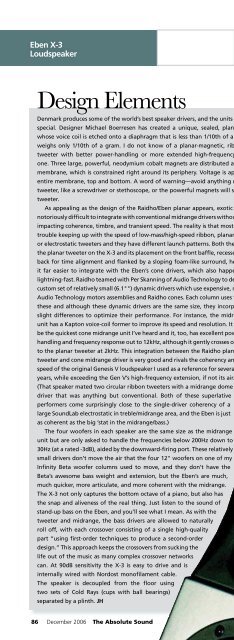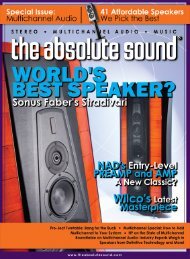You also want an ePaper? Increase the reach of your titles
YUMPU automatically turns print PDFs into web optimized ePapers that Google loves.
Eben X-3<br />
Loudspeaker<br />
Design Elements<br />
Denmark produces some of the world’s best speaker drivers, and the units in the Eben are quite<br />
special. Designer Michael Boerresen has created a unique, sealed, planar-magnetic tweeter<br />
whose voice coil is etched onto a diaphragm that is less than 1/10th of a millimeter thick and<br />
weighs only 1/10th of a gram. I do not know of a planar-magnetic, ribbon, or electrostatic<br />
tweeter with better power-handling or more extended high-frequency response than this<br />
one. Three large, powerful, neodymium cobalt magnets are distributed across the back of the<br />
membrane, which is constrained right around its periphery. Voltage is applied across the<br />
entire membrane, top and bottom. A word of warning—avoid anything metal near this<br />
tweeter, like a screwdriver or stethoscope, or the powerful magnets will suck it into the<br />
tweeter.<br />
As appealing as the design of the Raidho/Eben planar appears, exotic tweeters are<br />
notoriously difficult to integrate with conventional midrange drivers without negatively<br />
impacting coherence, timbre, and transient speed. The reality is that most cones have<br />
trouble keeping up with the speed of low-mass/high-speed ribbon, planar-magnetic,<br />
or electrostatic tweeters and they have different launch patterns. Both the design of<br />
the planar tweeter on the X-3 and its placement on the front baffle, recessed slightly<br />
back for time alignment and flanked by a sloping foam-like surround, help make<br />
it far easier to integrate with the Eben’s cone drivers, which also happen to be<br />
lightning-fast. Raidho teamed with Per Skanning of Audio Technology to develop a<br />
custom set of relatively small (6.1"") dynamic drivers which use expensive, massive<br />
Audio Technology motors assemblies and Raidho cones. Each column uses five of<br />
these and although these dynamic drivers are the same size, they incorporate<br />
slight differences to optimize their performance. For instance, the midrange<br />
unit has a Kapton voice-coil former to improve its speed and resolution. It may<br />
be the quickest cone midrange unit I’ve heard and it, too, has excellent powerhandling<br />
and frequency response out to 12kHz, although it gently crosses over<br />
to the planar tweeter at 2kHz. This integration between the Raidho planar<br />
tweeter and cone midrange driver is very good and rivals the coherency and<br />
speed of the original Genesis V loudspeaker I used as a reference for several<br />
years, while exceeding the Gen V’s high-frequency extension, if not its air.<br />
(That speaker mated two circular ribbon tweeters with a midrange dome<br />
driver that was anything but conventional. Both of these superlative<br />
performers come surprisingly close to the single-driver coherency of a<br />
large SoundLab electrostatic in treble/midrange area, and the Eben is just<br />
as coherent as the big ’stat in the midrange/bass.)<br />
The four woofers in each speaker are the same size as the midrange<br />
unit but are only asked to handle the frequencies below 200Hz down to<br />
30Hz (at a rated -3dB), aided by the downward-firing port. These relatively<br />
small drivers don’t move the air that the four 12" woofers on one of my<br />
Infinity Beta woofer columns used to move, and they don’t have the<br />
Beta’s awesome bass weight and extension, but the Eben’s are much,<br />
much quicker, more articulate, and more coherent with the midrange.<br />
The X-3 not only captures the bottom octave of a piano, but also has<br />
the snap and aliveness of the real thing. Just listen to the sound of<br />
stand-up bass on the Eben, and you’ll see what I mean. As with the<br />
tweeter and midrange, the bass drivers are allowed to naturally<br />
roll off, with each crossover consisting of a single high-quality<br />
part “using first-order techniques to produce a second-order<br />
design.” This approach keeps the crossovers from sucking the<br />
life out of the music as many complex crossover networks<br />
can. At 90dB sensitivity the X-3 is easy to drive and is<br />
internally wired with Nordost monofilament cable.<br />
The speaker is decoupled from the floor using<br />
two sets of Cold Rays (cups with ball bearings)<br />
separated by a plinth. JH<br />
The X-3’s<br />
performance is of<br />
reference quality in<br />
many respects<br />
86 December 2006 The Absolute Sound










